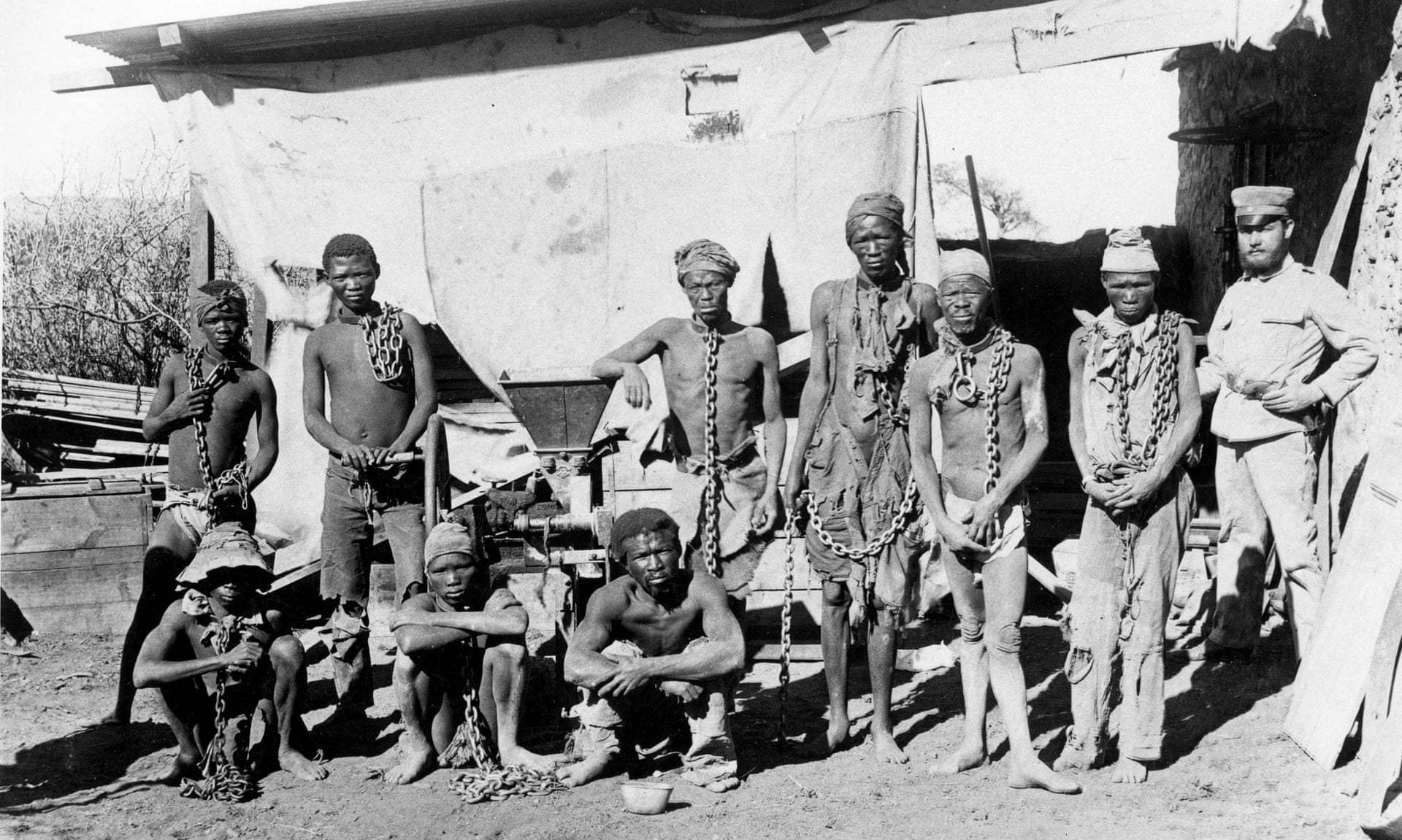
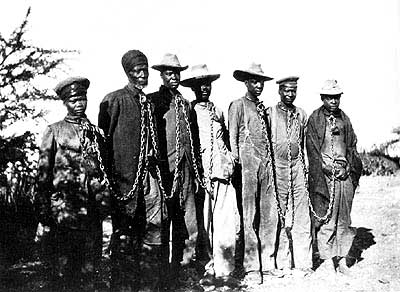
ヘレロおよびナマ虐殺
Völkermord
an den Herero und Nama, Herero
and Namaqua genocide,


/
Herero chained during the 1904 rebellion
1904年から1908[1907]年にかけてドイツ領南西アフリカ(現ナミビア)でのヘレロ戦争(Herero Wars)でおこった、 ヘレロとナマ虐殺(Völkermord an den Herero und Nama)は、ナマとオヴァヘレロの虐殺(Nama and Ovaherero Genocide)。数万人から10万人の犠牲者が出た。
この虐殺に関わったのが、当時南西アフリカを統治していたドイツ帝国の歩兵部隊と19世紀の
最後の四半世紀以降にケープ植民地を離れ北上してきたバスターあるいはレホボス・バスター(Rehoboth
Basters)と呼ばれる混血現地人のドイツ軍に訓練された歩兵である。
「ヘレロとナマ虐殺(Völkermord an den Herero und Nama)は、ドイツ領南西アフリカ(German South-West Africa , GSWA; 現・ナミビア)においてドイツ帝国が先住民族に対して行った虐殺。アフリカ分割の動きの中の1904年から1908 年[1]にかけて行われ、20世紀最初のジェノサイド(虐殺)と考えられている。アフリカ分割に加わったドイツ帝国による南部アフリカ侵攻で土地を追われ た先住民族のヘレロ族は1904年1月12日、サミュエル・マハレロ(英語版)の指揮の下、ドイツ人への無差別攻撃を開始した。これに対してドイツは8 月、ロタール・フォン・トロータ将軍の指揮でこれを破り(en:Battle of Waterberg)、三方から包囲して、カラハリ砂漠(Omaheke Desert)に追い込み、英領ベチュアナランドを目指して脱出した途上で多くが脱水症状のために死んだ。ベチュアナランドに辿り着いたのは1000人以 下だった。10月にはナマ族[2]——当時はナマクア——も蜂起したが同様の結果に終わった。ドイツは先住民を強制収容所へ収容したり強制労働に従事させ たりした。結果、戦後の人口統計からみて、約6万人のヘレロ族(全人口8万人のうち、80%)、1万人のナマ族(全人口2万人のうち50%)が死亡した。 ヘレロ族の死者数は2万4000人~最大10万人とする推計もある[3]。この虐殺の特徴は、一つは餓死であり、もう一つはナミブ砂漠に追いやられたヘレ ロ族とナマ族の使用する井戸に毒を入れたことによる中毒死である。ナミビアの首都ウィントフークには慰霊碑が建てられている[1]。2004年、ヘレロ戦 争(英語版)100周年を記念して、ドイツ連邦共和国経済協力・開発大臣ハイデマリー・ヴィーチョレック=ツォイルは、追悼と謝罪の意を全ドイツ人を代表 して表したが、ヘレロは財政的賠償を求めた。ヘレロ・ジェノサイド財団のエスター・ムインジャンゲ議長は「ドイツ政府が本当に謝ったとは思っていない」と して、ドイツ連邦議会での決議のような公式な謝罪をすべきとの考えを示した。また、ド イツによるこの虐殺が後のナチス・ドイツによるユダヤ人虐殺につながったとの見方に同意している[4]。 2021年5月28日、ドイツ政府は虐殺であったと初めて認め、11億ユーロを提供することを表明した[5]。ドイツは法的責任は認めず、「現在の視点で 見れば」ジェノサイドであったという留保付きであった[1]。ナミビア大統領ハーゲ・ガインゴブは「歴史的」とドイツを評価したが、虐殺の被害を受けな かったオバンボ族を主体とする政府が支援金を受け取る決定に、野党支持者が多いヘレロ族やナマ族からの反発や、ボツワナなど国外に住む被害者子孫が救済か ら漏れていることへの批判もある[1]。富裕層が多く「虐殺の受益者」という見方が広がるドイツ系ナミビア人には、報復に怯え、海外移住を検討する人もい る[1]」日本語ウィキペディア記事「」を加工)。
| The Herero
and Namaqua genocide or the Herero and Nama genocide was a
campaign of ethnic extermination and collective punishment waged by the
German Empire against the Herero (Ovaherero) and the Nama in German
South West Africa (now Namibia). It was the first genocide of the 20th
century,[5][6][7] occurring between 1904 and 1908.[1] In January 1904, the Herero people, who were led by Samuel Maharero, and the Nama people, who were led by Captain Hendrik Witbooi, rebelled against German colonial rule. On January 12, they killed more than 100 German settlers in the area of Okahandja, although women, children, missionaries and non-German Europeans were spared.[8] In August, German General Lothar von Trotha defeated the Ovaherero in the Battle of Waterberg and drove them into the desert of Omaheke, where most of them died of dehydration. In October, the Nama people also rebelled against the Germans, only to suffer a similar fate. Between 24,000 and 100,000 Hereros and 10,000 Nama died in the genocide.[2][9][10][11][12][13][14] The first phase of the genocide was characterised by widespread death from starvation and dehydration, due to the prevention of the Herero from leaving the Namib desert by German forces. Once defeated, thousands of Hereros and Namas were imprisoned in concentration camps, where the majority died of diseases, abuse, and exhaustion.[15][16] In 1985, the United Nations' Whitaker Report classified the aftermath as an attempt to exterminate the Herero and Nama peoples of South West Africa, and therefore one of the earliest attempts at genocide in the 20th century. In 2004, the German government recognised and apologised for the events, but ruled out financial compensation for the victims' descendants.[17] In July 2015, the German government and the speaker of the Bundestag officially called the events a "genocide". However, it refused to consider reparations at that time.[18][19] Despite this, the last batch of skulls and other remains of slaughtered tribesmen which were taken to Germany to promote racial superiority were taken back to Namibia in 2018, with Petra Bosse-Huber, a German Protestant bishop, describing the event as "the first genocide of the 20th century".[20][21] In May 2021, the German government agreed to pay €1.1 billion over 30 years to fund projects in communities that were impacted by the genocide.[1] |
ヘレロと
ナマの大量虐殺、またはヘレロとナマのジェノサイドは、ドイツ帝国がドイツ領南西アフリカ(現ナミビア)のヘレロ(オヴァヘレロ)とナマに対して行った民
族抹殺・集団処罰のキャンペーンである。1904年から1908年にかけて行われた20世紀最初の大量虐殺[5][6][7]である[1]。 1904年1月、サミュエル・マハレロ率いるヘレロ族とヘンドリック・ウィトボイ大尉率いるナマ族がドイツの植民地支配に反抗した。1月12日、彼らはオ カハンジャの地域で100人以上のドイツ人入植者を殺害したが、女性、子供、宣教師、非ドイツ系ヨーロッパ人は助かった[8]。 8月、ドイツのローター・フォン・トロタ将軍はウォーターバーグの戦いでオヴァヘレロを破り、オマヘケの砂漠に追いやったが、彼らの多くは脱水症状で死亡 した。10月、ナマ族もドイツ軍に反抗したが、同じような運命をたどった。 2][9][10][11][12][13][14]大量虐殺の第一段階は、ドイツ軍によってヘレロ人がナミブ砂漠を離れることができなかったため、飢え と脱水による死が広がったことが特徴的でした。敗戦後、数千人のヘレロ人とナマ人は強制収容所に収監され、大多数が病気、虐待、過労で死亡した[15] [16]。 1985年、国連のウィテカー報告書は、この余波を南西アフリカのヘレロ族とナマ族を絶滅させる試みであり、20世紀における最も早いジェノサイドの試み の1つであると分類している[15]。2004年、ドイツ政府はこの出来事を認識し謝罪したが、犠牲者の子孫に対する金銭的補償は否定した[17]。 2015年7月、ドイツ政府と連邦議会議長がこの出来事を公式に「ジェノサイド」と呼んだ。しかし、その時点では賠償金の検討を拒否した[18] [19]。 にもかかわらず、人種的優越性をアピールするためにドイツに持ち込まれた虐殺された部族の頭蓋骨などの遺骨の最後の一団は2018年にナミビアに引き取ら れ、ドイツのプロテスタント司教であるペトラ・ボッセ・フーバーはこの事件を「20世紀最初のジェノサイド」だと評した[20][21]。 2021年5月、ドイツ政府は大虐殺の影響を受けた地域のプロジェクトに資金を提供するため、30年間で11億ユーロを支払うことに同意した[1]。 |
| The original inhabitants of what
is now Namibia were the San and the Khoekhoe. Herero, who speak a Bantu language, were originally a group of cattle herders who migrated into what is now Namibia during the mid-18th century. The Herero seized vast swaths of the arable upper plateaus which were ideal for cattle grazing. Agricultural duties, which were minimal, were assigned to enslaved Khoisan and Bushmen. Over the rest of the 18th century, the Herero slowly drove the Khoisan into the dry, rugged hills to the south and east.[22][23] The Hereros were a pastoral people whose entire way of life centred on their cattle. The Herero language, while limited in its vocabulary for most areas, contains more than a thousand words for the colours and markings of cattle. The Hereros were content to live in peace as long as their cattle were safe and well-pastured, but became formidable warriors when their cattle were threatened.[24] According to Robert Gaudi, "The newcomers, much taller and more fiercely warlike than the indigenous Khoisan people, were possessed of the fierceness that comes from basing one's way of life on a single source: everything they valued, all wealth and personal happiness, had to do with cattle. Regarding the care and protection of their herds, the Herero showed themselves utterly merciless, and far more 'savage' than the Khoisan had ever been. Because of their dominant ways and elegant bearing, the few Europeans who encountered Herero tribesmen in the early days regarded them as the region's 'natural aristocrats.'"[25] By the time of the Scramble for Africa, the area which was occupied by the Herero was known as Damaraland. The Nama were pastorals and traders and lived to the south of the Herero.[26]: 22 In 1883, Adolf Lüderitz, a German merchant, purchased a stretch of coast near Lüderitz Bay (Angra Pequena) from the reigning chief. The terms of the purchase were fraudulent, but the German government nonetheless established a protectorate over it.[27] At that time, it was the only overseas German territory deemed suitable for European settlement.[28] Chief of the neighbouring Herero, Maharero rose to power by uniting all the Herero.[29] Faced with repeated attacks by the Khowesin, a clan of the Khoekhoe under Hendrik Witbooi, he signed a protection treaty on 21 October 1885 with Imperial Germany's colonial governor Heinrich Ernst Göring (father of World War I flying ace and World War II convicted war criminal Hermann Göring) but did not cede the land of the Herero. This treaty was renounced in 1888 due to lack of German support against Witbooi but it was reinstated in 1890.[30] The Herero leaders repeatedly complained about violation of this treaty, as Herero women and girls were raped by Germans, a crime that the German judges and prosecuctors were reluctant to punish.[31] In 1890 Maharero's son, Samuel, signed a great deal of land over to the Germans in return for helping him to ascend to the Ovaherero throne, and to subsequently be established as paramount chief.[30][32] German involvement in ethnic fighting ended in tenuous peace in 1894.[33]: 48 In that year, Theodor Leutwein became governor of the territory, which underwent a period of rapid development, while the German government sent the Schutztruppe (imperial colonial troops) to pacify the region.[34] |
現在のナミビアの原住民は、サン族とコエホ族である。 18世紀半ばに現在のナミビアに移住してきたヘレロ族は、バンツー語を話す牧畜民であった。ヘレロは、牛の放牧に適した耕作地である高原の広大な土地を押 さえた。農作業は、奴隷であるコイサンやブッシュマンに任され、最低限の仕事しかしなかった。18世紀の残りの期間、ヘレロはコイサンをゆっくりと南と東の乾燥した険しい丘陵地帯に追いやった[22] [23]。 ヘレロ族は牧畜民であり、その生活の全ては家畜を中心としたものであった。ヘレロ語は、ほとんどの地域で語彙が限られているにもかかわらず、牛の色や模様 に関する1000以上の単語を含んでいる。ヘレロ人は、家畜が安全で十分に飼育されている間は平和に暮らしていたが、家畜が脅かされると手強い戦士になっ た[24]。 ロバート・ガウディによれば、「先住民のコイサン族よりもはるかに背が高く、獰猛な戦士である新参者は、生活様式を一つの源に置くことから来る獰猛さを 持っていた。ヘレロ族は家畜の世話や保護に関して、コイサン族とは比べものにならないほど無慈悲で、「野蛮」であることを自ら示していた。その支配的なや り方と優雅な身なりから、初期にヘレロ族に出会った数少ないヨーロッパ人は、彼らをこの地域の「自然の貴族」と見なした」[25]。 アフリカのためのスクランブル」の頃には、ヘレロ族が住んでいた地域はダマラランドと呼ばれるようになっていた。ナマ族は牧民と商人で、ヘレロ族の南に住 んでいた[26]: 22。 1883年、ドイツ商人のアドルフ・リュデリッツがリュデリッツ湾(アングラ・ペケナ)付近の海岸一帯を支配者である首長から購入した。購入条件は詐欺的 なものだったが、それでもドイツ政府はこの地を保護領とした[27]。 当時、ヨーロッパ人の入植に適した唯一のドイツ領海外であった[28]。 隣接するヘレロの族長であったマハレロは、全ヘレロを統合して権力を握った[29]。ヘンドリック・ウィトボイ率いるコウェホ族のコウェシンから繰り返し 攻撃を受けた彼は、1885年10月21日に帝国ドイツの植民地総督ハインリッヒ・エルンスト・ゲーリング(第一次世界大戦の空戦特使で第二次世界大戦で は戦犯ヘルマン・ゲーリングの父親)と保護条約を締結したがヘレロの土地は割愛された。この条約は、1888年にウィトボイに対するドイツの支援が得られ なかったため破棄されたが、1890年に復活した[30]。 ヘレロの指導者たちは、この条約に違反し、ヘレロの女性や少女がドイツ人にレイプされ、その罪をドイツの裁判官や検事が処罰することに難色を示すことを繰 り返し訴えていた[31]。 1890年、マハレロの息子サミュエルは、オヴァヘレロの王位に就くことを支援し、その後最高酋長に就任する見返りとして、ドイツに多くの土地を譲渡した [30][32]。 48その年、テオドール・ロイトヴァインが領土の総督となり、急速な発展期を迎える一方、ドイツ政府はシュトルツルッペ(帝国植民地 軍)を派遣してこの地域を平和にした[34]。 |
| German colonial policy Both German colonial authorities and European settlers envisioned a predominately white "new African Germany," wherein the native populations would be put onto reservations and their land distributed among settlers and companies.[35] Under German colonial rule, colonists were encouraged to seize land and cattle from the native Herero and Nama peoples and to subjugate them as slave laborers.[33]: 19, 34, 50, 149 [36][37]: 8, 22 [38][39][40]: 147–149, 185–186, 209 Resentment brewed among the native populations over their loss of status and property to German ranchers arriving in South West Africa, and the dismantling of traditional political hierarchies. Previously ruling tribes were reduced to the same status as the other tribes they had previously ruled over and enslaved. This resentment contributed to the Herero Wars that began in 1904.[33]: 57 [41] Major Theodor Leutwein, the Governor of German South West Africa, was well aware of the effect of the German colonial rule on Hereros. He later wrote : "The Hereros from early years were a freedom-loving people, courageous and proud beyond measure. On the one hand, there was the progressive extension of German rule over them, and on the other their own sufferings increasing from year to year."[42] |
ドイツの植民地政策 ドイツ植民地当局もヨーロッパ人入植者も、先住民を保留地に入れ、その土地を入植者や企業に分配するという、白人優位の「新アフリカ・ドイツ」を構想して いた[35]。ドイツ植民地支配下では、入植者は先住民のヘレロ人やナマ人から土地や牛を奪い、彼らを奴隷労働者として服従させることが奨励された [33]。 19, 34, 50, 149 [36][37]: 8, 22 [38][39][40]: 147-149, 185-186, 209 南西アフリカに到着したドイツ人牧場主に地位と財産を奪われ、伝統的な政治的階層が解体されたことで、先住民の間に怨念が芽生えたのである。それまで支配 していた部族は、それまで支配し、奴隷にしていた他の部族と同じ地位に落とされたのである。この恨みは1904年に始まったヘレロ戦争に寄与した [33]。 57 [41] ドイツ領南西アフリカの総督テオドール・ロイトヴァイン少佐は、ドイツの植民地支配がヘレロ族に及ぼす影響をよく理解していた。彼は後にこう書いている。 「ヘレロ人は幼い頃から自由を愛し、勇気と誇りにあふれた人々であった。一方では、彼らに対するドイツの支配が徐々に拡大し、他方では、彼ら自身の苦しみ が年ごとに増していた」[42]。 |
| The Dietrich case In January 1903, a German trader named Dietrich was walking from his homestead to the nearby town of Omaruru to buy a new horse. Halfway to Dietrich's destination, a wagon carrying the son of a Herero chief, his wife, and their son stopped by. In a common courtesy in Hereroland, the chief's son offered Dietrich a ride.[43] That night, however, Dietrich got very drunk and after everyone was asleep, he attempted to rape the wife of the chief's son. When she resisted, Dietrich shot her dead. When he was tried for murder in Windhoek, Dietrich denied attempting to rape his victim. He alleged that he awoke thinking the camp was under attack and fired blindly into the darkness. The killing of the Herero woman, he claimed, was an unfortunate accident. The court acquitted him, alleging that Dietrich was suffering from "tropical fever" and temporary insanity.[43] According to Leutwein, the murder "aroused extraordinary interest in Hereroland, especially since the murdered woman had been the wife of the son of a Chief and the daughter of another. Everywhere the question was asked: Have White people the right to shoot native women?"[43] Governor Leutwein intervened. He had the Public Prosecutor appeal Dietrich's acquittal, a second trial took place (before the colony's supreme court), and this time Dietrich was found guilty of manslaughter and imprisoned.[42] The move prompted violent objections of German settlers who considered Leutwein a "race traitor".[citation needed] |
ディートリッヒ事件 1903年1月、ドイツ人貿易商のディートリッヒは、新しい馬を買うために自分の家から近くのオマルルという町まで歩いていました。その途中、ヘレロ族の 酋長の息子とその妻、そして息子を乗せた馬車が立ち寄りました。ヘレロではよくある礼儀で、酋長の息子はディートリッヒを乗せてくれることになった [43]。 しかし、その夜、ディートリッヒは大酒を飲み、皆が寝静まった後、酋長の息子の妻を強姦しようとした。彼女が抵抗したため、ディートリッヒは彼女を射殺し た。ウィントフックで殺人罪で裁判にかけられた時、ディートリッヒは被害者をレイプしようとしたことを否定した。彼は、「キャンプが攻撃されていると思 い、暗闇の中でやみくもに発砲した」と主張した。ヘレロ族の女性を殺したのは不運な事故だった。裁判所は、ディートリッヒは「熱帯熱」と一時的な心神喪失 に陥っていたと主張し、彼を無罪とした[43]。 ロイトヴァインによれば、この殺人は「ヘレロランドで異常な関心を呼び起こし、特に殺された女性が酋長の息子の妻であり、他の酋長の娘であったことから」 であった。白人は先住民の女性を射殺する権利があるのか、という疑問がいたるところで投げかけられた」[43]。 ロイトワイン総督が介入した。彼は検事にディートリッヒの無罪を訴えさせ、二審は植民地の最高裁判所で行われ、今度はディートリッヒは過失致死罪で有罪と なり投獄された[42]。 この動きは、ロイトヴァインを「人種の裏切り者」とみなすドイツ系入植者の激しい反対を招いた[引用者註:1]。 |
| Rising tension In 1903, some of the Nama clans rose in revolt under the leadership of Hendrik Witbooi.[34] A number of factors led the Herero to join them in January 1904. One of the major issues was land rights. In 1903 the Herero learned of a plan to divide their territory with a railway line and set up reservations where they would be concentrated.[44] The Herero had already ceded more than a quarter of their 130,000 km2 (50,000 sq mi) territory to German colonists by 1903,[33]: 60 before the Otavi railway line running from the African coast to inland German settlements was completed.[45]: 230 Completion of this line would have made the German colonies much more accessible and would have ushered a new wave of Europeans into the area.[46]: 133 Historian Horst Drechsler states that there was discussion of the possibility of establishing and placing the Herero in native reserves and that this was further proof of the German colonists' sense of ownership over the land. Drechsler illustrates the gap between the rights of a European and an African; the Reichskolonialbund (German Colonial League) held that, in regards to legal matters, the testimony of seven Africans was equivalent to that of a colonist.[46]: 132, 133 According to Bridgman, there were racial tensions underlying these developments; the average German colonist viewed native Africans as a lowly source of cheap labour, and others welcomed their extermination.[33]: 60 A new policy on debt collection, enforced in November 1903, also played a role in the uprising. For many years, the Herero population had fallen in the habit of borrowing money from colonist moneylenders at extreme interest rates (see usury). For a long time, much of this debt went uncollected and accumulated, as most Herero had no means to pay. To correct this growing problem, Governor Leutwein decreed with good intentions that all debts not paid within the next year would be voided.[33]: 59 In the absence of hard cash, traders often seized cattle, or whatever objects of value they could get their hands on, as collateral. This fostered a feeling of resentment towards the Germans on the part of the Herero people, which escalated to hopelessness when they saw that German officials were sympathetic to the moneylenders who were about to lose what they were owed.[33]: 60 Racial tension was also at play. The German settlers often referred to black Africans as "baboons" and treated them with contempt.[33]: 62 [47] One missionary reported: "The real cause of the bitterness among the Hereros toward the Germans is without question the fact that the average German looks down upon the natives as being about on the same level as the higher primates ('baboon' being their favourite term for the natives) and treat them like animals. The settler holds that the native has a right to exist only in so far as he is useful to the white man. This sense of contempt led the settlers to commit violence against the Hereros."[47] The contempt manifested itself particularly in the concubinage of native women. In a practice referred to in Südwesterdeutsch as Verkafferung, native women were taken by male European traders and ranchers both willingly and by force.[47] |
高まる緊張 1903年、ナマ族の一部がヘンドリック・ウィトボイの指導のもとで反乱を起こした[34]。いくつかの要因が重なって、1904年1月にヘレロ族が彼ら に加わることになった。 大きな問題のひとつは、土地の権利であった。1903年、ヘレロは鉄道によって領土を分割し、彼らが集中する居留地を設置する計画を知った[44]。アフ リカ沿岸から内陸のドイツ人入植地へと走るオタビ鉄道が完成する前の1903年、ヘレロはすでに13万km2(5万平方マイル)の領土の4分の1をドイツ の入植者に割譲していた[33]: 60。 [この路線の完成により、ドイツ植民地はよりアクセスしやすくなり、ヨーロッパ人の新しい波がこの地域に押し寄せることになったであろう[46]。 133 歴史家のホルスト・ドレクスラーは、ヘレロを先住民の保護区に設置する可能性が議論され、それがドイツ人入植者の土地に対する所有意識のさらなる証拠で あったと述べている。ドレクスラーはヨーロッパ人とアフリカ人の権利の差を説明する。ドイツ植民地同盟は、法的な問題に関しては、7人のアフリカ人の証言 は植民地主義者のそれと同等であるとした[46]。 ブリッグマンによれば、こうした動きの根底には人種的緊張があった。平均的なドイツの植民者は、アフ リカ人を安価な労働力の下等な供給源と見なし、一方で彼らの絶滅を歓迎する者もいた[33]: 60。 1903年11月に施行された債権回収に関する新しい政策もまた、蜂起に一役買った。長年、ヘレロの人々は植民地の金貸しから極端な金利で金を借りる習慣 があった(「高利貸し」の項を参照)。ヘレロ族の多くは支払う手段を持たず、長い間、この借金の多くは回収されずに蓄積されていった。この増大する問題を 是正するため、ロイトワイン総督は、次の1年以内に支払われないすべての債務を無効にすることを善意で布告した[33]。 59 現金がないため、商人は牛や手に入る価値のあるものは何でも担保として差し押さえることが多かった。このことは、ヘレロの人々の側にドイツ人に対する憤り を醸成し、それが、ドイツの役人が貸したものを失おうとしている金貸しに同情的であるのを見て、絶望にエスカレートした[33]: 60。 人種的な緊張もあった。ドイツ人入植者はしばしばアフリカ系黒人を「ヒヒ」と呼び、侮蔑的に扱った[33]: 62 [47]。 ある宣教師はこう報告している。「ヘレロ人のドイツ人に対する恨みは、ドイツ人が原住民を霊長類と同程度に見下し、動物のように扱っていることに起因す る。入植者は、原住民は白人の役に立つ限りにおいてのみ存在する権利があると考える。この侮蔑の感覚が、入植者たちをヘレロ族に対する暴力に走らせた」 [47]。 その侮蔑は、特に先住民の女性の妾腹に表れた。SüdwesterdeutschではVerkafferungと呼ばれる慣習で、先住民の女性はヨーロッ パ人の男性商人や牧場主によって、自ら望んで、あるいは力づくで連れ去られた[47]。 |
| Revolts In 1903, the Hereros saw an opportunity to revolt. At that time, there was a distant Khoisan tribe in the south called the Bondelzwarts, who resisted German demands to register their guns. The Bondelzwarts engaged in a firefight with the German authorities which led to three Germans killed and a fourth wounded. The situation deteriorated further, and the governor of the Herero colony, Major Theodor Leutwin, went south to take personal command, leaving almost no troops in the north.[48] The Herero revolted in early 1904, killing between 123 and 150 German settlers, as well as seven Boers and three women,[33]: 74 in what Nils Ole Oermann calls a "desperate surprise attack".[49] The timing of their attack was carefully planned. After successfully asking a large Herero clan to surrender their weapons, Governor Leutwein was convinced that they and the rest of the native population were essentially pacified and so withdrew half of the German troops stationed in the colony.[33]: 56 Led by Chief Samuel Maharero, the Herero surrounded Okahandja and cut railroad and telegraph links to Windhoek, the colonial capital. Maharero then issued a manifesto in which he forbade his troops to kill any Englishmen, Boers, uninvolved peoples, women and children in general, or German missionaries.[33]: 70 The Herero revolts catalysed a separate revolt and attack on Fort Namutoni in the north of the country a few weeks later by the Ondonga.[50][51] A Herero warrior interviewed by German authorities in 1895 had described his people's traditional way of dealing with suspected cattle rustlers, a treatment which, during the uprising, was regularly extended to German soldiers and civilians, "We came across a few Khoisan whom of course we killed. I myself helped to kill one of them. First we cut off his ears, saying, 'You will never hear Herero cattle lowing.' Then we cut off his nose, saying, 'Never again shall you smell Herero cattle.' And then we cut off his lips, saying, 'You shall never again taste Herero cattle.' And finally we cut his throat."[52] According to Robert Gaudi, "Leutwein knew that the wrath of the German Empire was about to fall on them and hoped to soften the blow. He sent desperate messages to Chief Samuel Maherero in hopes of negotiating an end to the war. In this, Leutwein acted on his own, heedless of the prevailing mood in Germany, which called for bloody revenge."[53] The Hereros, however, were emboldened by their success and had come to believe that, "the Germans were too cowardly to fight in the open," and rejected Leutwein's offers of peace.[54] One missionary wrote, "The Germans are filled with fearful hate. I must really call it a blood thirst against the Hereros. One hears nothing but talk of 'cleaning up,' 'executing,' 'shooting down to the last man,' 'no pardon,' etc."[54] |
反乱 1903年、ヘレロ人は反乱の機会をうかがう。当時、南部にはボンデルツワルトと呼ばれるコイサン族がおり、彼らはドイツ軍の銃の登録要求に抵抗してい た。ボンデルスワルト族はドイツ当局と銃撃戦を繰り広げ、ドイツ兵3名が死亡、4名が負傷した。状況はさらに悪化し、ヘレロ植民地の総督テオドール・ロイ トウィン少佐は自ら指揮をとるために南下し、北部にはほとんど軍隊を残さなかった[48]。 ヘレロは1904年初頭に反乱を起こし、123人から150人のドイツ人入植者と7人のボーア人、3人の女性[33]、つまりニルス・オレ・オエルマンが 「決死の奇襲」と呼ぶ74人を殺害した[49]。 彼らの攻撃のタイミングは慎重に計画されたものであった。ロイトヴァイン総督は、ヘレロの大集団に武器を放棄するよう求めることに成功した後、彼らとその 他の先住民が本質的に平和になったと確信し、植民地に駐留していたドイツ軍の半分を撤退させた[33]: 56 ヘレロ族は首長のサミュエル・マハレロに率いられ、オカハンジャを包囲し、植民地の首都であるウィントフックへの鉄道と電信を切断した。マハレロはその後 マニフェストを発表し、イギリス人、ボーア人、無関係の人々、女性や子供全般、ドイツ人宣教師の殺害を禁止した[33]: 70 ヘレロの反乱は、数週間後にオンドンガ族による別の反乱と北部のナムトニ要塞への攻撃を誘発した[50], [51] 。 1895年にドイツ当局のインタビューを受けたヘレロの戦士は、牛泥棒と疑われる者に対するヘレロの伝統的な対処法について述べており、その対処法は、反 乱の間、ドイツ兵や民間人にも定期的に適用されました。私たちはコイサン族に遭遇し、もちろん殺しました。私はそのうちの一人を殺すのを手伝いました。ヘ レロの牛の鳴き声が聞こえなくなるぞ』と言って、まず耳を切り落とした。そして、「二度とヘレロ牛の臭いを嗅ぐことはない」と言って、鼻を切り落とした。 そして唇を切り落とした 「二度とヘレロ牛の味はしない」と言った そして最後に彼の喉を切り裂いた」[52]。 ロバート・ガウディによれば、「ロイトヴァインはドイツ帝国の怒りが自分たちに降りかかろうとしていることを知り、その打撃を和らげることを望んだ。彼は 酋長サミュエル・マヘロに必死のメッセージを送り、戦争終結の交渉に望みを託した。ロイトワインは、血生臭い復讐を求めるドイツの風潮を無視して、独断で 行動した」[53]。 しかし、ヘレロ人はその成功によって勇気づけられ、「ドイツ人は公然と戦うには臆病すぎる」と考えるようになり、ロイトヴァインの講和の申し出を拒否した [54]。 ある宣教師は、「ドイツ人は恐るべき憎悪に満ちている。ヘレロ族に対する血の渇きと言わざるを得ない。一掃する』『処刑する』『最後の一人まで撃ち殺す』 『赦さない』などの話ばかりを聞く」[54]。 |
| According
to Robert Gaudi, "The Germans suffered more than defeat in the early
months of 1904; they suffered humiliation, their brilliant modern army
unable to defeat a rabble of 'half-naked savages.' Cries in the
Reichstag, and from the Kaiser himself, for total eradication of the
Hereros grew strident. When a leading member of the Social Democratic
Party pointed out that the Hereros were as human as any German and
possessed immortal souls, he was howled down by the entire conservative
side of the legislature."[54] Leutwein was forced to request reinforcements and an experienced officer from the German government in Berlin.[55]: 604 Lieutenant-General Lothar von Trotha was appointed commander-in-chief (German: Oberbefehlshaber) of South West Africa, arriving with an expeditionary force of 10,000 troops on 11 June.[56][57] Meanwhile, Leutwein was subordinate to the civilian Colonial Department of the Prussian Foreign Office, which was supported by Chancellor Bernhard von Bülow, while General Trotha reported to the military German General Staff, which was supported by Emperor Wilhelm II.[33]: 85 [58] Leutwein wanted to defeat the most determined Herero rebels and negotiate a surrender with the remainder to achieve a political settlement.[55]: 605 Trotha, however, planned to crush the native resistance through military force. He stated that: My intimate knowledge of many central African nations (Bantu and others) has everywhere convinced me of the necessity that the Negro does not respect treaties but only brute force.[27]: 173 By late spring of 1904, German troops were pouring into the colony. In August 1904, the main Herero forces were surrounded and crushed at the Battle of Waterberg.[48]: 21 |
ド
イツ軍は1904年の初期に敗北を喫しただけでなく、屈辱を味わった。帝国議会でも、皇帝自身からも、ヘレロ族の完全な根絶を求める声が大きくなった。社
会民主党の有力議員が、ヘレロ人はドイツ人と同じ人間であり、不滅の魂を持っていると指摘すると、保守派の議員全員から罵声を浴びせられた」[54]。 ロイトヴァインはベルリンのドイツ政府に援軍と経験豊富な将校を要請せざるを得なくなった[55]: 604 ローター・フォン・トロタ中将が南西アフリカの司令官(ドイツ語でOberbefehlshaber)となり、1万人の部隊で6月11日に遠征して来た [56][57]。 一方、ロイトヴァインはベルンハルト・フォン・ビューロー首相の支持するプロイセン外務省の文民植民地局に従属し、トロサ将軍は皇帝ヴィルヘルム2世の支 持する軍のドイツ参謀本部に報告した[33]: 85 [58]. ロイトヴァインは最も強固なヘレロの反乱軍を倒し、残りの反乱軍と降伏交渉をして政治的解決を図ろうとした[55]: 605 トロサはしかし、軍事力によって先住民の抵抗を粉砕しようと計画した。彼は次のように述べている。 多くの中央アフリカの国々(バンツーとその他)に関する私の親密な知識は、黒人が条約を尊重せず、武力のみであることの必要性をどこでも確信させた」 [27]。 173 1904年の晩春までに、ドイツ軍は植民地に流入していた。1904年8月、ヘレロの主戦力はウォーターバーグの戦いで包囲され、粉砕された[48]: 21。 |
| Genocide In 1900, Kaiser Wilhelm II had been enraged by the killing of Baron Clemens von Ketteler, the Imperial German minister plenipotentiary in Beijing, during the Boxer Rebellion. The Kaiser took it as a personal insult from a people he viewed as racially inferior, all the more because of his obsession with the "Yellow Peril". On 27 July 1900, the Kaiser gave the infamous Hunnenrede (Hun speech) in Bremerhaven to German soldiers being sent to Imperial China, ordering them to show the Boxers no mercy and to behave like Attila's Huns.[59] General von Trotha had served in China, and was chosen in 1904 to command the expedition to German South West Africa precisely because of his record in China.[60] In 1904, the Kaiser was furious by the latest revolt in his colonial empire by a people whom he also viewed as inferior, and took the Herero rebellion as a personal insult, just as he had viewed the Boxers' assassination of Baron von Ketteler.[61] The both tactless and bloodthirsty language that Wilhelm II used about the Herero people in 1904 is strikingly similar to the language he had used about the Chinese Boxers in 1900.[62] However, the Kaiser denied, together with Chancellor von Bülow, von Trotha's request to quickly quell the rebellion.[63] No written order by Wilhelm II ordering or authorising genocide has survived.[61] In February 1945 an Allied bombing raid destroyed the building housing all of the documents of the Prussian Army from the Imperial period.[64] Despite this fact, surviving documents indicate that Trotha used the same tactics in Namibia that he had used in China, only on a must vaster scale. It is also known that throughout the genocide Trotha sent regular reports to both the General Staff and to the Kaiser.[65] Historian Jeremy-Sarkin Hughes believes that regardless of whether or not a written order was given, the Kaiser must have given General von Trotha verbal orders.[66] According to Hughes, the fact that Trotha was decorated and not court-martialed after the genocide became public knowledge lends support to the thesis that he was acting under orders.[67] General von Trotha stated his proposed solution to end the resistance of the Herero people in a letter, before the Battle of Waterberg:[68]: 11 I believe that the nation as such should be annihilated, or, if this was not possible by tactical measures, have to be expelled from the country ... This will be possible if the water-holes from Grootfontein to Gobabis are occupied. The constant movement of our troops will enable us to find the small groups of this nation who have moved backwards and destroy them gradually. |
ジェノサイド 1900年、カイザー・ウィルヘルム2世は、北京のドイツ全権公使クレメンス・フォン・ケトラー男爵が義和団の乱で殺害されたことに激怒していた。カイ ザーはこれを、自分が劣等人種とみなす民族からの個人的な侮辱と受け止め、さらに「黄禍」に執着していたため、なおさらであった。1900年7月27日、 カイザーはブレーマーハーフェンで帝国中国に送られるドイツ兵に対して悪名高いHunnenrede(フン族の演説)を行い、ボクサーに容赦せず、アッ ティラのフン族のように振る舞うよう命令した[59] フォン・トロタ将軍は中国で勤務しており、まさに中国での実績から1904年にドイツの南西アフリカへの遠征の指揮官に選ばれた[60]。 1904年、カイザーは自分の植民地帝国において、自分も劣っていると見なしていた民族による最新の反乱に激怒し、ボクサーによるフォン・ケットラー男爵 の暗殺を見たのと同じように、ヘレロの反乱を個人的な侮辱として受け止めた[61]。 [しかし、カイザーはフォン・ビューロー首相とともに、フォン・トロサの反乱鎮圧の要請を否定している[63]。 ヴィルヘルム2世による大量虐殺を命令・許可する文書は現存していない[61]。 1945年2月に連合軍の空襲により、帝国時代のプロイセン軍のすべての文書を収容する建物が破壊された[64]。 この事実にもかかわらず、残存する文書は、トロサが中国で用いたのと同じ戦術を、より大きな規模でナミビアで用いたことを示すものである。歴史家のジェレ ミー・サーキン・ヒューズは、文書による命令がなされたか否かにかかわらず、カイザーはフォン・トロサ将軍に口頭で命令したに違いないと考えている [65]。 [ヒューズによれば、大量虐殺が公になった後、トロサが軍法会議にかけられず叙勲されたという事実は、彼が命令に基づいて行動していたというテーゼの裏付 けとなる[67]。 トロサ将軍はウォーターベルクの戦いの前に、ヘレロの人々の抵抗を終わらせるための解決案を手紙に記載している[68]。 11 私は、そのような民族は全滅させるか、戦術的な手段で不可能であれば、国から追放しなければならないと考えています...。これは、グルートフォンテーン からゴバビスまでの水飲み場を占領すれば可能でしょう。我が軍の絶え間ない移動により、後方に移動したこの国の小集団を発見し、徐々に破壊することができ るだろう。 |
| Trotha's
troops defeated 3,000–5,000 Herero combatants at the Battle of
Waterberg on 11–12 August 1904 but were unable to encircle and
annihilate the retreating survivors.[55]: 605 The pursuing German forces prevented groups of Herero from breaking from the main body of the fleeing force and pushed them further into the desert. As exhausted Herero fell to the ground, unable to go on, German soldiers killed men, women, and children.[69]: 22 Jan Cloete, acting as a guide for the Germans, witnessed the atrocities committed by the German troops and deposed the following statement:[46]: 157 I was present when the Herero were defeated in a battle in the vicinity of Waterberg. After the battle all men, women, and children who fell into German hands, wounded or otherwise, were mercilessly put to death. Then the Germans set off in pursuit of the rest, and all those found by the wayside and in the sandveld were shot down and bayoneted to death. The mass of the Herero men were unarmed and thus unable to offer resistance. They were just trying to get away with their cattle. A portion of the Herero escaped the Germans and went to the Omaheke Desert, hoping to reach British Bechuanaland; fewer than 1,000 Herero managed to reach Bechuanaland, where they were granted asylum by the British authorities.[70] To prevent them from returning, Trotha ordered the desert to be sealed off.[71] German patrols later found skeletons around holes 13 m (43 ft) deep that had been dug in a vain attempt to find water. Some sources also state that the German colonial army systematically poisoned desert water wells.[69]: 22 [72] Maherero and 500–1,500 men crossed the Kalahari into Bechuanaland where he was accepted as a vassal of the Batswana chief Sekgoma.[73] On 2 October, Trotha issued a warning to the Herero:[DE 1] I, the great general of the German soldiers, send this letter to the Herero. The Herero are German subjects no longer. They have killed, stolen, cut off the ears and other parts of the body of wounded soldiers, and now are too cowardly to want to fight any longer. I announce to the people that whoever hands me one of the chiefs shall receive 1,000 marks, and 5,000 marks for Samuel Maherero. The Herero nation must now leave the country. If it refuses, I shall compel it to do so with the 'long tube' [cannon]. Any Herero found inside the German frontier, with or without a gun or cattle, will be executed. I shall spare neither women nor children. I shall give the order to drive them away and fire on them. Such are my words to the Herero people.[76] He further gave orders that: This proclamation is to be read to the troops at roll-call, with the addition that the unit that catches a captain will also receive the appropriate reward, and that the shooting at women and children is to be understood as shooting above their heads, so as to force them to run [away]. I assume absolutely that this proclamation will result in taking no more male prisoners, but will not degenerate into atrocities against women and children. The latter will run away if one shoots at them a couple of times. The troops will remain conscious of the good reputation of the German soldier.[37]: 56 Trotha gave orders that captured Herero males were to be executed, while women and children were to be driven into the desert where their death from starvation and thirst was to be certain; Trotha argued that there was no need to make exceptions for Herero women and children, since these would "infect German troops with their diseases", the insurrection Trotha explained "is and remains the beginning of a racial struggle".[55]: 605 After the war, Trotha argued that his orders were necessary, writing in 1909 that "If I had made the small water holes accessible to the womenfolk, I would run the risk of an African catastrophe comparable to the Battle of Beresonia."[69]: 22 |
トロサ軍は1904年8月11日から12日にかけてのウォーターバーグ
の戦いで3,000人から5,000人のヘレロ人の戦闘員を破ったが、退却する生存者を包囲し全滅させることはできなかった[55]: 605。 追撃するドイツ軍は、ヘレロの集団が逃走部隊の本体から離脱するのを阻止し、さらに砂漠に押し込んでいった。疲弊したヘレロが先に進めず地面に倒れ込む と、ドイツ兵は男、女、子供を殺した[69]: 22 ヤン・クロエテはドイツ軍のガイドとして行動し、ドイツ軍が行った残虐行為を目撃して以下の声明を供述している[46]: 157 私は、ヘレロがウォーターベルクの近辺での戦闘で敗北したときに立ち会った。戦いの後、ドイツ軍の手に落ちたすべての男、女、子供は、負傷していようとい まいと、容赦なく殺された。そして、ドイツ軍は残りの者を追って出発し、道端や砂地で見つけた者はすべて射殺され、銃剣で刺し殺された。ヘレロ人の多くは 丸腰で、抵抗することもできない。ただ、家畜を連れて逃げようとしただけなのだ。 ヘレロの一部はドイツ軍から逃れ、オマヘケ砂漠に向かい、イギリスのベチュアナランドにたどり着くことを目指したが、ベチュアナランドにたどり着いたヘレ ロは1000人足らずで、イギリス当局から亡命を許された[70]。 トロサは、彼らの帰還を防ぐために砂漠を封鎖するよう命じた[71]。また、ドイツ植民地軍が砂漠の井戸に組織的に毒を盛ったとする資料もある[69]: 22 [72] マヘレロは500-1500人の部下と共にカラハリを越えてベチュアランドに入り、バツワナの族長セクゴマの家臣として受け入れられた[73]。 10月2日、トロサはヘレロ族に警告を発した[DE 1]。 ドイツ兵の大将である私は、この手紙をヘレロに送る。ヘレロ族はもはやドイツの臣民ではない。彼らは殺し、盗み、負傷した兵士の耳や体の一部を切り落と し、今や臆病でこれ以上戦うことを望んでいない。私は民衆に告ぐ、首領の一人を私に渡した者には1000マルクを、サミュエル・マヘレロには5000マル クを与えると。ヘレロ族は国外退去せよ。もし拒否するならば、私は『長筒』[大砲]で強制的に退去させるだろう。ドイツ国境内で発見されたヘレロは、銃や 家畜の有無にかかわらず、処刑される。女も子供も容赦しない。追い立てろ、撃ちまくれと命令する。これが私のヘレロ人に対する言葉である[76]。 彼はさらに次のような命令を下した。 この布告は点呼の際に部隊に読み上げられ、隊長を捕らえた部隊には相応の報酬が与えられること、女子供への銃撃は彼らの頭上を撃ち、彼らに逃げさせるよう に理解されることが付け加えられる[76]。この布告によって、男性の捕虜はいなくなるが、女性や子供に対する残虐行為に発展することはないと、私は絶対 的に思っている。後者は2、3回発砲すれば逃げ出すでしょう。軍隊はドイツ兵の良い評判を意識し続けるだろう[37]。 56 トロサは、捕らえられたヘレロの男性は処刑され、女性や子供は飢えと渇きによる死が確実な砂漠に追いやられるという命令を下した。トロサは、ヘレロの女性 や子供は「ドイツ軍に病気をうつす」ので例外とする必要はない、トロサは暴動を「人種闘争の始まりであり続ける」と説明している[55]。 [戦後、トロサは自分の命令が必要であったと主張し、1909年に「もし私が小さな水場を女性の民衆にも使えるようにしていたら、ベレソニアの戦いに匹敵 するアフリカの大災害の危険を冒していただろう」[69]: 22と書いている。 |
| The
German general staff was aware of the atrocities that were taking
place; its official publication, named Der Kampf, noted that: This bold enterprise shows up in the most brilliant light the ruthless energy of the German command in pursuing their beaten enemy. No pains, no sacrifices were spared in eliminating the last remnants of enemy resistance. Like a wounded beast the enemy was tracked down from one water-hole to the next, until finally he became the victim of his own environment. The arid Omaheke [desert] was to complete what the German army had begun: the extermination of the Herero nation.[77][78] Alfred von Schlieffen (Chief of the Imperial German General Staff) approved of Trotha's intentions in terms of a "racial struggle" and the need to "wipe out the entire nation or to drive them out of the country", but had doubts about his strategy, preferring their surrender.[79] Governor Leutwein, later relieved of his duties, complained to Chancellor von Bülow about Trotha's actions, seeing the general's orders as intruding upon the civilian colonial jurisdiction and ruining any chance of a political settlement.[55]: 606 According to Professor Mahmood Mamdani from Columbia University, opposition to the policy of annihilation was largely the consequence of the fact that colonial officials looked at the Herero people as a potential source of labour, and thus economically important.[68]: 12 For instance, Governor Leutwein wrote that: I do not concur with those fanatics who want to see the Herero destroyed altogether ... I would consider such a move a grave mistake from an economic point of view. We need the Herero as cattle breeders ... and especially as labourers.[27]: 169 Having no authority over the military, Chancellor Bülow could only advise Emperor Wilhelm II that Trotha's actions were "contrary to Christian and humanitarian principle, economically devastating and damaging to Germany's international reputation".[55]: 606 Upon the arrival of new orders at the end of 1904, prisoners were herded into labor camps, where they were given to private companies as slave labourers or exploited as human guinea pigs in medical experiments.[10][80] |
ド
イツ軍参謀本部は、残虐行為が行われていることを認識していた。「デア・カンプフ」と名付けられた公式出版物には、次のように記されている。 この大胆な作戦は、敗走する敵を追撃するドイツ軍司令部の冷酷なエネル ギーを最も輝かしく示している。敵の抵抗の最後の残党を排除するために、いかなる苦痛も、いかなる犠牲も惜しまない。傷ついた獣のように、敵は水飲み場か ら水飲み場へと追い詰められ、ついには自らの環境の犠牲となったのである。乾燥したオマヘケ(砂漠)は、ドイツ軍が始めたこと、すなわちヘレロ民族の絶滅 を完成させることになった[77][78]。 アルフレッド・フォン・シュリーフェン(帝国ドイツ参謀総長)は「人種闘争」と「国民全体を一掃するか国外に追い出す」必要性という観点からトロサの意図 を認めていたが、彼の戦略には疑問を持っており、彼らの降伏を望んでいた[79]。 後に職務を解かれたロイトヴァイン総督は、トロサの行動についてフォン・ビューロー首相に不満を述べ、将軍の命令は民間の植民地の管轄に侵入し、政治的解 決の可能性を台無しにすると考えた[55]: 606 コロンビア大学のマームード・マムダニ教授によれば、殲滅政策への反対は、植民地の役人がヘレロの人々を労働力の源として、経済的に重要視した結果が大き い[68]: 606: 12 例えば、ロイトワイン総督は次のように書いている。 私は、ヘレロの完全な滅亡を望む狂信者たちに同調しているわけではない。私は、経済的な観点から、そのような動きは重大な誤りであると考える。私たちは、 牧畜業者として......とりわけ労働力としてヘレロを必要としているのだ」[27]。 169 軍に対する権限を持たないビューロー首相は、トロサの行動は「キリスト教的・人道的原則に反し、経済的に破壊的であり、ドイツの国際的評判に損害を与え る」と皇帝ヴィルヘルム2世に助言することしかできなかった[55]: 606。 1904年末に新たな命令が下されると、囚人たちは労働キャンプに集められ、そこで奴隷労働者として民間企業に譲渡されたり、医学実験のモルモットとして 搾取されたりした[10][80]。 |
| Concentration camps Survivors of the massacre, the majority of whom were women and children, were eventually put in places like Shark Island concentration camp, where the German authorities forced them to work as slave labour for German military and settlers. All prisoners were categorised into groups fit and unfit for work, and pre-printed death certificates indicating "death by exhaustion following privation" were issued.[83] The British government published their well-known account of the German genocide of the Nama and Herero peoples in 1918.[84] Many Herero and Nama died of disease, exhaustion, starvation and malnutrition.[7][85][86] Estimates of the mortality rate at the camps are between 45%[87][88] and 74%.[40]: 196–216 [87][88] Food in the camps was extremely scarce, consisting of rice with no additions.[89]: 92 As the prisoners lacked pots and the rice they received was uncooked, it was indigestible; horses and oxen that died in the camp were later distributed to the inmates as food.[37]: 75 Dysentery and lung diseases were common.[37]: 76 Despite those conditions, the prisoners were taken outside the camp every day for labour under harsh treatment by the German guards, while the sick were left without any medical assistance or nursing care.[37]: 76 Many Herero and Nama were worked to death.[7] Shootings, hangings, beatings, and other harsh treatment of the forced labourers (including use of sjamboks) were common.[37]: 76 [90] A 28 September 1905 article in the South African newspaper Cape Argus detailed some of the abuse with the heading: "In German S. W. Africa: Further Startling Allegations: Horrible Cruelty". In an interview with Percival Griffith, "an accountant of profession, who owing to hard times, took up on transport work at Angra Pequena, Lüderitz", related his experiences. There are hundreds of them, mostly women and children and a few old men ... when they fall they are sjamboked by the soldiers in charge of the gang, with full force, until they get up ... On one occasion I saw a woman carrying a child of under a year old slung at her back, and with a heavy sack of grain on her head ... she fell. The corporal sjamboked her for certainly more than four minutes and sjamboked the baby as well ... the woman struggled slowly to her feet, and went on with her load. She did not utter a sound the whole time, but the baby cried very hard.[91] During the war, a number of people from the Cape (in modern-day South Africa) sought employment as transport riders for German troops in Namibia. Upon their return to the Cape, some of these people recounted their stories, including those of the imprisonment and genocide of the Herero and Nama people. Fred Cornell, an aspiring British diamond prospector, was in Lüderitz when the Shark Island concentration camp was being used. Cornell wrote of the camp: Cold – for the nights are often bitterly cold there – hunger, thirst, exposure, disease and madness claimed scores of victims every day, and cartloads of their bodies were every day carted over to the back beach, buried in a few inches of sand at low tide, and as the tide came in the bodies went out, food for the sharks.[91][92] Shark Island was the worst of the German South West African camps.[93] Lüderitz lies in southern Namibia, flanked by desert and ocean. In the harbour lies Shark Island, which then was connected to the mainland only by a small causeway. The island is now, as it was then, barren and characterised by solid rock carved into surreal formations by the hard ocean winds. The camp was placed on the far end of the relatively small island, where the prisoners would have suffered complete exposure to the strong winds that sweep Lüderitz for most of the year.[91] German Commander Ludwig von Estorff wrote in a report that approximately 1,700 prisoners (including 1,203 Nama) had died by April 1907. In December 1906, four months after their arrival, 291 Nama died (a rate of more than nine people per day). Missionary reports put the death rate at 12–18 per day; as many as 80% of the prisoners sent to Shark Island eventually died there.[91] There are accusations of Herero women being coerced into sex slavery as a means of survival.[68]: 12 [94] A black and white photo depicting the severed head of a Shark Island prisoner, which was used for medical experimentation. Head of Shark Island prisoner used for medical experimentation Trotha was opposed to contact between natives and settlers, believing that the insurrection was "the beginning of a racial struggle" and fearing that the colonists would be infected by native diseases.[55]: 606 Benjamin Madley argues that although Shark Island is referred to as a concentration camp, it functioned as an extermination camp or death camp.[95][96][97] |
強制収容所 虐殺の生存者は、その大半が女性と子供であり、最終的にシャークアイランド強制収容所などに入れられ、ドイツ当局は彼らをドイツ軍と入植者のための奴隷労 働者として働かせることを強制した。すべての囚人は労働に適したグループと適さないグループに分類され、「窮乏に伴う疲労による死」を示すあらかじめ印刷 された死亡証明書が発行された[83]。 イギリス政府は1918年にナマ族とヘレロ族に対するドイツの大量虐殺の有名な記録を公表した[84]。 多くのヘレロ人とナマ人が病気、消耗、飢餓、栄養失調で死亡した[7][85][86]。収容所での死亡率の推定は45%[87][88]から74%であ る[40]。 196-216 [87][88] 収容所での食料は極めて乏しく、添加物のない米で構成されていた[89]: 92 囚人には鍋がなく、受け取った米は未調理のため消化が悪く、収容所で死んだ馬や牛が後に食料として収容者に配られた[37]: 75 赤痢と肺病はよく見られた。 [37]: 76 そのような状況にもかかわらず、囚人たちは毎日収容所の外に連れ出され、ドイツ人看守による過酷な扱いの下で労働させられ、病人は医療支援や看護を受けら れないまま放置された[37]: 76 多くのヘレロ人とナマ人が死ぬまで働かされた[7]。 強制労働者に対する銃殺、絞首刑、殴打、その他の過酷な扱い(スヤンボックの使用を含む)は一般的だった[37]: 76 [90] 南アフリカの新聞『Cape Argus』の1905年9月28日の記事には、見出しとともに虐待の一部が詳述されている。「ドイツ領南西アフリカにて。さらなる驚くべき疑惑。恐ろし い残酷さ」という見出しで、虐待の一部を詳細に説明している。パーシバル・グリフィスとのインタビューでは、「職業は会計士で、苦境のためリューデリッツ のアングラ・ペケーナで輸送の仕事を始めた」と、その体験を語っている。 何百人もいて、ほとんどが女、子供で、老人が何人かいる。ある時、1歳にも満たない子供を背負い、重い穀物袋を頭に乗せた女性が倒れるのを見た。伍長は4 分以上も彼女をsjambokedし、赤ん坊もsjambokedしました...女性はゆっくりと立ち上がり、荷物を持ち続けようともがきました。彼女は その間ずっと声を出さなかったが、赤ん坊は非常に激しく泣いた[91]。 戦争中、ケープ(現在の南アフリカ)の多くの人々が、ナミビアのドイツ軍の輸送騎手として職を求めた。ケープに戻ったこれらの人々の中には、ヘレロ族とナ マ族の投獄と大量虐殺を含む彼らの物語を語った者もいた。英国人のダイヤモンド探鉱者フレッド・コーネルは、シャークアイランド強制収容所が使用されてい た時、リューデリッツにいました。コーネルはこの収容所についてこう書いている。 寒さ-そこでは夜はしばしば厳しい寒さである-飢え、渇き、露出、病気、狂気が毎日何人もの犠牲者を出し、カート一杯の彼らの死体が毎日裏浜に運ばれ、干 潮時には数インチの砂に埋められ、潮が満ちてくると死体はサメの餌になって出ていった」[91][92]とある。 リューデリッツはナミビア南部に位置し、砂漠と海に挟まれた場所にある。港にはシャークアイランドがあり、当時は小さな土手道だけで本土とつながってい た。この島は、当時と同じように不毛の地であり、固い岩が海風に削られて超現実的な形をしているのが特徴だ。収容所は比較的小さな島の端に置かれ、囚人た ちはリューデリッツを一年中覆う強い風に完全にさらされることになっただろう[91]。 ドイツ軍司令官ルートヴィヒ・フォン・エストルフは、1907年4月までに約1,700人の捕虜(1,203人のナマ人を含む)が死亡したと報告書に記し ている。到着から4ヶ月後の1906年12月には、291人のナマが死亡した(1日あたり9人以上の割合である)。宣教師の報告によると、死亡率は1日あ たり12-18人であり、シャークアイランドに送られた囚人の80%もが最終的にそこで死亡している[91]。 ヘレロの女性が生存の手段として性奴隷にさせられていたという告発がある[68]。 12 [94] トロサは原住民と入植者の接触に反対しており、暴動は「人種闘争の始まり」と考え、植民者が原住民の病気に感染することを恐れていた[55]: 606 ベンジャミン・マドリーは、シャークアイランドは強制収容所(Shark Island concentration camp)と呼ばれているが、絶滅収容所あるいは死の収容所として機能していたと論じている[95] [96][97]。 |
| Medical experiments and
scientific racism Prisoners were used for medical experiments and their illnesses or their recoveries from them were used for research.[98] Experiments on live prisoners were performed by Dr. Bofinger, who injected Herero that were suffering from scurvy with various substances including arsenic and opium; afterwards he researched the effects of these substances via autopsy.[26]: 225 Experimentation with the dead body parts of the prisoners was rife. Zoologist Leonhard Schultze-Jena [de] (1872–1955) noted taking "body parts from fresh native corpses" which according to him was a "welcome addition", and he also noted that he could use prisoners for that purpose.[99] An estimated 300 skulls[100] were sent to Germany for experimentation, in part from concentration camp prisoners.[101] In October 2011, after three years of talks, the first 20 of an estimated 300 skulls stored in the museum of the Charité were returned to Namibia for burial.[102][103] In 2014, 14 additional skulls were repatriated by the University of Freiburg.[104] |
医学的実験と科学的人種差別 囚人は医学的な実験に使われ、彼らの病気やそこからの回復が研究に用いられた[98]。 生きた囚人に対する実験はボフィンガー博士によって行われ、壊血病にか かったヘレロにヒ素やアヘンなど様々な物質を注射し、その後、解剖によってこれらの物質の影響を研究した[26]:225 捕 虜の死体の一部を使った実験も盛んに行われた。動物学者のレオンハルト・シュルツェ-イエナ[de](1872-1955)は、彼によれば「新鮮な土着の 死体から身体の一部を採取する」ことは「歓迎すべきこと」であり、またそのために囚人を利用することができると述べている[99]。 推定300個の頭蓋骨[100]が実験のためにドイツに送られ、その一 部は強制収容所の囚人からであった[101]。 2011年10月、3年間の協議の後、シャリテの博物館に保管されていた推定300個の頭蓋骨のうち最初の20個が埋葬のためにナミビアに戻された[102][103]。 2014年にフライブルク大学によって別の頭蓋骨が追加返還された[104]。 |
| Number of victims A census conducted in 1905 revealed that 25,000 Herero remained in German South West Africa.[45] According to the Whitaker Report, the population of 80,000 Herero was reduced to 15,000 "starving refugees" between 1904 and 1907.[105] In Colonial Genocide and Reparations Claims in the 21st Century: The Socio-Legal Context of Claims under International Law by the Herero against Germany for Genocide in Namibia by Jeremy Sarkin-Hughes, a number of 100,000 victims is given. Up to 80% of the indigenous populations were killed.[106][107] Newspapers reported 65,000 victims when announcing that Germany recognized the genocide in 2004.[108][109] |
犠牲者数 1905年に実施された国勢調査では、25,000人のヘレロがドイツ領南西アフリカに残っていることが明らかになった[45]。 ウィテカー報告書によれば、8万人のヘレロの人口は1904年から 1907年の間に1万5千人の「飢餓難民」にまで減少した[105]。 Jeremy Sarkin-Hughesによる『21世紀における植民地虐殺と賠償請求: The Socio-Legal Context of Claims under International Law by the Herero against Germany for Genocide in Namibia』では、10万人の犠牲者と いう数字が示されている。先住民の最大80%が殺害された[106][107]。 2004年にドイツがジェノサイドを認めたことを発表した際、新聞は65,000人 の犠牲者を報告した[108][109]。 |
| Aftermath With the closure of concentration camps, all surviving Herero were distributed as labourers for settlers in the German colony. From that time on, all Herero over the age of seven were forced to wear a metal disc with their labour registration number,[68]: 12 and banned from owning land or cattle, a necessity for pastoral society.[89]: 89 About 19,000 German troops were engaged in the conflict, of which 3,000 saw combat. The rest were used for upkeep and administration. The German losses were 676 soldiers killed in combat, 76 missing, and 689 dead from disease.[37]: 88 The Reiterdenkmal (English: Equestrian Monument) in Windhoek was erected in 1912 to celebrate the victory and to remember the fallen German soldiers and civilians. Until after Independence, no monument was built to the killed indigenous population. It remains a bone of contention in independent Namibia.[110] The campaign cost Germany 600 million marks. The normal annual subsidy to the colony was 14.5 million marks.[37]: 88 [111] In 1908, diamonds were discovered in the territory, and this did much to boost its prosperity, though it was short-lived.[45]: 230 In 1915, during World War I, the German colony was taken over and occupied by the Union of South Africa, which was victorious in the South West Africa campaign.[112] South Africa received a League of Nations mandate over South West Africa on 17 December 1920.[113][114] |
その後 強制収容所の閉鎖に伴い、生き残ったヘレロはすべてドイツ植民地の入植者のための労働力として分配された。それ以降、7歳以上のすべてのヘレロは、労働者 登録番号を記した金属製の円盤を強制的に装着させられた[68]。 12され、牧畜社会の必需品である土地や家畜を所有することが禁止された[89]: 89。 約19,000人のドイツ軍がこの紛争に従事し、そのうち3,000人が戦闘に参加した。残りは維持と管理のために使われた。ドイツ軍の損失は戦死676 名、行方不明76名、病死689名であった[37]: 88 ウィントフックのReiterdenkmal(英語:Equestrian Monument)は、勝利を祝い、亡くなったドイツ兵と民間人を追悼するために1912年に建立されたものである。独立後まで、殺された先住民のための 記念碑は建てられていない。独立したナミビアでは今でも争点となっている[110]。 この作戦でドイツは6億マルクを費やした。1908年、領内でダイヤモンドが発見され、短期間であったが繁栄を極めた[45]: 230。 第一次世界大戦中の1915年、ドイツ植民地は南西アフリカ作戦で勝利した南アフリカ連邦によって占領された[112]。南アフリカは1920年12月 17日に南西アフリカに対する国際連盟の委任統治を受けた[113][114]。 |
| Link between the Herero genocide
and the Holocaust The Herero genocide has commanded the attention of historians who study complex issues of continuity between the Herero genocide and The Holocaust.[115] It is argued that the Herero genocide set a precedent in Imperial Germany that would later be followed by Nazi Germany's establishment of death camps.[116][117] According to Benjamin Madley, the German experience in South West Africa was a crucial precursor to Nazi colonialism and genocide. He argues that personal connections, literature, and public debates served as conduits for communicating colonialist and genocidal ideas and methods from the colony to Germany.[118] Tony Barta, an honorary research associate at La Trobe University, argues that the Herero genocide was an inspiration for Hitler in his war against the Jews, Slavs, Romani, and others who he described as "non-Aryans".[119] According to Clarence Lusane, Eugen Fischer's medical experiments can be seen as a testing ground for medical procedures which were later followed during the Nazi Holocaust.[87] Fischer later became chancellor of the University of Berlin, where he taught medicine to Nazi physicians. Otmar Freiherr von Verschuer was a student of Fischer, Verschuer himself had a prominent pupil, Josef Mengele.[120][121] Franz Ritter von Epp, who was later responsible for the liquidation of virtually all Bavarian Jews and Roma as governor of Bavaria, took part in the Herero and Nama genocide as well.[122] Mahmood Mamdani argues that the links between the Herero genocide and the Holocaust are beyond the execution of an annihilation policy and the establishment of concentration camps and there are also ideological similarities in the conduct of both genocides. Focusing on a written statement by General Trotha which is translated as: I destroy the African tribes with streams of blood ... Only following this cleansing can something new emerge, which will remain.[27]: 174 Mamdani takes note of the similarity between the aims of the General and the Nazis. According to Mamdani, in both cases there was a Social Darwinist notion of "cleansing", after which "something new" would "emerge".[68]: 12 |
ヘレロの大量虐殺とホロコーストの関連性 ヘレロの大量虐殺は、ヘレロの大量虐殺とホロコーストの間の連続性の複雑な問題を研究する歴史家の注目を集めた[115]。 ヘレロの大量虐殺が帝国ドイツの先例を作り、それが後にナチスドイツの死のキャンプの設立に続くと主張される[116][117]。 ベンジャミン・マドリーによれば、南西アフリカにおけるドイツの経験はナチスの植民地主義や大量虐殺の決定的な前兆であった。ラ・トローブ大学の名誉研究 員であるトニー・バルタは、ヘレロの大量虐殺がユダヤ人、スラブ人、ロマニ人、その他彼が「非アーリア人」と表現する人々に対する戦争においてヒトラーの インスピレーションになったと論じている[119]。 クラレンス・ルサーンによれば、オイゲン・フィッシャーの医学実験は、 後にナチスのホロコーストで踏襲された医療処置の実験場と見ることができる[87]。フィッシャーは後にベルリン大学の総長となり、そこでナチの医師たち に医学を教えていた。オトマール・フライヘア・フォン・ヴェルシュアーはフィッシャーの生徒であり、ヴェルシュアー自身は著名な弟子であるヨーゼフ・メン ゲレがいた[120][121]。フランツ・リッター・フォン・エップは、 後にバイエルン州知事として事実上すべてのバイエルンのユダヤ人とロマ人を整理 する責任を負っていたが、同様にヘレロとナマの大量虐殺に参加をしていた[122]。 120. Michael H. Kater (2011). "The Nazi Symbiosis: Human Genetics and Politics in the Third Reich". Bulletin of the History of Medicine. 85 (3): 515–516. マームード・マムダニは、ヘレロの大量虐殺とホロコーストの関係は、殲滅政策の実行と強制収容所の設置にとどまらず、両者の大量虐殺の行為には思想的な類 似性もあると論じている[122]。トロサ将軍が書いた文章に注目すると、次のように訳されている。 私はアフリカの部族を血の流れで破壊する......。この浄化の後にのみ、残る新しいものが出現することができる」[27]。 174 マムダニは、将軍とナチスの目的の類似性に着目している。マムダニによれば、どちらの場合も「浄化」という社会ダーウィニズム的な観念があり、その後に 「新しい何か」が「出現」するのである[68]: 12 ※87:Clarence Lusane (2002) Hitler's Black Victims: The Historical Experiences of European Blacks, Africans and African Americans During the Nazi Era (Crosscurrents in African American History), pp. 50–51, Routledge, New York. ※120: Michael H. Kater (2011). "The Nazi Symbiosis: Human Genetics and Politics in the Third Reich". Bulletin of the History of Medicine. 85 (3): 515–516.→Sheila Faith Weiss . The Nazi Symbiosis: Human Genetics and Politics in the Third Reich. Chicago: University of Chicago Press, 2010 ※122: Ben Kiernan (2007) Blood and Soil, a World History of Genocide and Extermination from Sparta to Darfur, p. 36, Yale University Press. "There, German participants in the 1904-8 genocide of the Herero and Nama peoples include the future Nazi governor of Bavaria, Franz Ritter von Epp, who during World War II presided over the liquidation of virtually Bavaria's Jews and Gypsies." |
| Recognition In 1985, the United Nations' Whitaker Report classified the massacres as an attempt to exterminate the Herero and Nama peoples of South West Africa, and therefore one of the earliest cases of genocide in the 20th century.[123] In 1998, German President Roman Herzog visited Namibia and met Herero leaders. Chief Munjuku Nguvauva demanded a public apology and compensation. Herzog expressed regret but stopped short of an apology. He pointed out that international law requiring reparation did not exist in 1907, but he undertook to take the Herero petition back to the German government.[124] On 16 August 2004, at the 100th anniversary of the start of the genocide, a member of the German government, Heidemarie Wieczorek-Zeul, Germany's Federal Minister for Economic Development and Cooperation, officially apologised and expressed grief about the genocide, declaring in a speech that: We Germans accept our historical and moral responsibility and the guilt incurred by Germans at that time.[125] She ruled out paying special compensations, but promised continued economic aid for Namibia which in 2004 amounted to $14M a year.[17] This number has been significantly increased since then, with the budget for the years 2016–17 allocating a sum total of €138M in monetary support payments.[126] The Trotha family travelled to Omaruru in October 2007 by invitation of the royal Herero chiefs and publicly apologised for the actions of their relative. Wolf-Thilo von Trotha said, We, the von Trotha family, are deeply ashamed of the terrible events that took place 100 years ago. Human rights were grossly abused that time.[127] |
認識 1985年、国連のウィテカー報告書は、この虐殺を南西アフリカのヘレロ族とナマ族を絶滅させるための試みと分類し、20世紀における最も早い大量虐殺の 事例の1つであるとした[123]。 Revised and updated report on the question of the prevention and punishment of the crime of genocide / prepared by Benjamin G. Whitaker. UN. Special Rapporteur on Prevention and Punishment of the Crime of Genocide, 1985 https://digitallibrary.un.org/record/108352?ln=en 1998年、ドイツのローマン・ヘルツォーク大統領がナミビアを訪れ、ヘレロの指導者と面会した。酋長のムンジュク・ングバウヴァは公的な謝罪と補償を要 求した。ヘルツォークは遺憾の意を示したが、謝罪には至らなかった。彼は、賠償を要求する国際法は1907年には存在しなかったと指摘したが、ヘレロの請 願をドイツ政府に持ち帰ることを約束した[124]。 2004年8月16日、大量虐殺の開始100周年に際して、ドイツ政府のメンバーであるドイツ連邦経済発展・協力大臣のハイデマリー・ヴィエツォレク= ツォイルは公式に謝罪し、大量虐殺に対する悲しみを表明し、演説で次のように宣言した。 我々ドイツ人は歴史的、道徳的責任と当時のドイツ人が負った罪悪感を受け入れる[125]。 彼女は特別な補償を支払うことを否定したが、2004年に年間1400万ドルに達したナミビアへの経済援助の継続を約束した[17]。 この数字はそれ以来大幅に増加し、2016年から17年の予算は金銭支援の支払いで合計138万ユーロを割り当てている[126]。 トロサ一家は2007年10月に王室ヘレロ族酋長の招待でオマルルを訪れ、親族の行為について公に謝罪した。ヴォルフ=ティロ・フォン・トロサは言った。 私たちフォン・トロサ一家は、100年前に起こった恐ろしい出来事を深く恥じています。あの時は人権が著しく濫用されたのです[127]。 |
| Negotiations and agreement The Herero filed a lawsuit in the United States in 2001 demanding reparations from the German government and Deutsche Bank, which financed the German government and companies in Southern Africa.[128][129] With a complaint filed with the United States District Court for the Southern District of New York in January 2017, descendants of the Herero and Nama people sued Germany for damages in the United States. The plaintiffs sued under the Alien Tort Statute, a 1789 U.S. law often invoked in human rights cases. Their proposed class-action lawsuit sought unspecified sums for thousands of descendants of the victims, for the "incalculable damages" that were caused.[130][131] Germany seeks to rely on its state immunity as implemented in US law as the Foreign Sovereign Immunities Act, arguing that, as a sovereign nation, it cannot be sued in US courts in relation to its acts outside the United States.[132] In March 2019, the judge dismissed the claims due to the exceptions to sovereign immunity being too narrow for the case.[133] In September 2020, the Second Circuit stated that the claimants did not prove that money used to buy property in New York could be traced back to wealth resulting from the seized property and therefore the lawsuit could not overcome Germany's immunity. In June 2021, the Supreme Court declined to hear a petition to revive the case.[134] Germany, while admitting brutality in Namibia, at first refused to call it a "genocide", claiming that the term only became international law in 1945. However, in July 2015, then foreign minister Frank-Walter Steinmeier issued a political guideline stating that the massacre should be referred to as a "war crime and a genocide". Bundestag president Norbert Lammert wrote an article in Die Zeit that same month referring to the events as a genocide. These events paved the way for negotiations with Namibia.[135][136][137] In 2015, the German government began negotiations with Namibia over a possible apology, and by 2016, Germany committed itself to apologizing for the genocide, as well as to refer to the event as a genocide; but the actual declaration was postponed while negotiations stalled over questions of compensation.[137][138][139] On 11 August 2020, following negotiations over a potential compensation agreement between Germany and Namibia, President Hage Geingob of Namibia stated that the German government's offer was "not acceptable", while German envoy Ruprecht Polenz said he was "still optimistic that a solution can be found."[140] On 28 May 2021, the German government announced that it was formally recognizing the atrocities committed as a genocide, following five years of negotiations. The declaration was made by foreign minister Heiko Maas, who also stated that Germany was asking Namibia and the descendants of the genocide victims for forgiveness. In addition to recognizing the events as a genocide, Germany agreed to give as a "gesture of recognition of the immeasurable suffering" €1.1 billion in aid to the communities impacted by the genocide.[141][107] Following the announcement, the agreement needs to be ratified by both countries' parliaments, after which Germany would send its president, Frank-Walter Steinmeier, to officially apologize for the genocide. The nations agreed not to use the term "reparation" to describe the financial aid package.[141][107] The agreement was criticized by the chairman of the Namibian Genocide Association, Laidlaw Peringanda, who insisted that Germany should purchase their ancestral lands back from the descendants of the German settlers and return it to the Herero and Nama people. The agreement was also criticized because negotiations were held solely between the German and Namibian governments, and did not include representatives of the Herero and Nama people.[141][107] |
交渉と合意 ヘレロ族は2001年にドイツ政府と南部アフリカの企業に融資していたドイツ銀行に対して賠償を求める訴訟を米国で起こした[128][129]。 2017年1月にニューヨーク南部地区連邦地方裁判所に提出した訴状により、ヘレロ族とナマ族の子孫は米国で損害賠償を求めてドイツを提訴した。原告ら は、外国人不法行為法(1789年に制定された米国の法律で、人権訴訟でしばしば発動される)に基づき訴えた。彼らの提案した集団訴訟は、引き起こされた 「計り知れない損害」のために、犠牲者の何千もの子孫のために不特定の金額を求めた[130][131]。 ドイツは、主権国家として、米国外の行為に関して米国の裁判所で訴えられることができないと主張し、外国主権免責法として米国の法律で実施されている国家 免疫に頼ろうとしている[132] 2019年3月に、裁判官は主権免疫に対する例外は本件にとってあまりにも狭いため請求を棄却していた[133]。 2020年9月、第2巡回控訴裁は、ニューヨークで不動産を購入するために使われたお金が、押収された不動産から生じた富にさかのぼることができることを 請求者が証明しなかったため、この訴訟はドイツの免責を克服することができないと述べている。2021年6月、最高裁はこの訴訟の復活を求める申立ての審 理を拒否した[134]。 ドイツは、ナミビアでの蛮行を認めながらも、当初は「ジェノサイド」と呼ぶことを拒否し、この用語が国際法になったのは1945年であると主張していた。 しかし2015年7月、当時の外相フランク=ヴァルター・シュタインマイヤーは、この虐殺を「戦争犯罪とジェノサイド」と呼ぶべきとする政治的指針を発表 している。連邦議会議長のノルベルト・ランメルトは同月、Die Zeit誌にこの出来事をジェノサイドと言及する記事を書いた。これらの出来事はナミビアとの交渉に道を開くことになった[135][136] [137]。 2015年、ドイツ政府は謝罪の可能性をめぐってナミビアとの交渉を開始し、2016年までにドイツはジェノサイドについて謝罪するとともに、この出来事 をジェノサイドと言及することを約束したが、補償の問題で交渉が停滞する間、実際の宣言は先延ばしにされた[137][138][139]。 2020年8月11日、ドイツとナミビアの間の補償合意の可能性をめぐる交渉の後、ナミビアのハゲ・ゲイングブ大統領はドイツ政府の申し出は「受け入れら れない」と述べ、ドイツの特使ルプレヒト・ポレンツ氏は「解決策が見つかることをまだ楽観している」と述べている[140]。 2021年5月28日、ドイツ政府は5年間の交渉の末、行われた残虐行為をジェノサイドとして正式に認めると発表した。この宣言は外務大臣ハイコ・マース によって行われ、ドイツはナミビアとジェノサイド犠牲者の子孫に許しを求めていることも明言した。この出来事をジェノサイドとして認めることに加え、ドイ ツは「計り知れない苦しみを認識するジェスチャー」として、ジェノサイドによって影響を受けたコミュニティに11億ユーロの援助を与えることに同意した [141][107]。 発表の後、合意は両国の議会によって批准される必要があり、その後、ドイツはジェノサイドに対して公式に謝罪するためにフランク=ヴァルター・シュタイン マイヤー大統領を派遣することになる。両国は、財政支援パッケージを説明するために「賠償」という用語を使用しないことに合意した[141][107]。 この合意は、ナミビア大量虐殺協会のレイドロー・ペリンガンダ会長によって批判され、ドイツはドイツ人入植者の子孫から先祖代々の土地を買い戻し、ヘレロ 族とナマ族に返還すべきと主張されるに至った。また、交渉がドイツ政府とナミビア政府の間だけで行われ、ヘレロ族とナマ族の代表を含んでいないことから批 判を浴びた[141][107]。 |
| Repatriation Peter Katjavivi, a former Namibian ambassador to Germany, demanded in August 2008 that the skulls of Herero and Nama prisoners of the 1904–1908 uprising, which were taken to Germany for scientific research to claim the superiority of white Europeans over Africans, be returned to Namibia. Katjavivi was reacting to a German television documentary which reported that its investigators had found more than 40 of these skulls at two German universities, among them probably the skull of a Nama chief who had died on Shark Island near Lüderitz.[142] In September 2011 the skulls were returned to Namibia.[143] In August 2018, Germany returned all of the remaining skulls and other human remains which were examined in Germany to scientifically promote white supremacy.[20][21] This was the third such transfer, and shortly before it occurred, German Protestant bishop Petra Bosse-Huber stated "Today, we want to do what should have been done many years ago – to give back to their descendents the remains of people who became victims of the first genocide of the 20th century."[20][21] As part of the repatriation process, the German government announced on 17 May 2019 that it would return a stone symbol it took from Namibia in the 1900s.[144] |
返還 ピーター・カチャビビ元駐ドイツ大使は2008年8月、ヨーロッパ白人のアフリカ人に対する優位性を主張する科学研究のためにドイツに持ち込まれた 1904年から1908年の蜂起のヘレロ人とナマ人の囚人の頭蓋骨をナミビアに返還するよう要求した。カチャヴィヴィは、ドイツのテレビのドキュメンタ リー番組が、その調査員がドイツの2つの大学で40以上のこれらの頭蓋骨を発見し、その中にはおそらくリューデリッツ近くのシャーク島で死亡したナマ人の 首長の頭蓋骨があると報告したことに反応していた[142] 2011年9月に頭蓋骨はナミビアに返還された[143] 2018年8月にはドイツで、科学的に白人至上主義を促進するために調査した頭蓋骨と他の人骨が残り全て返還された。 [20][21] このような移送は3回目で、その直前にドイツのプロテスタント司教ペトラ・ボッセ・フーバーは「今日、私たちは何年も前に行われるべきだったことを行いた い-20世紀最初の大量虐殺の犠牲者となった人々の遺骨を彼らの子孫に返すために」[20][21] と述べている。 本国への返還の一環として、ドイツ政府は2019年5月17日に、1900年代にナミビアから持ち出した石のシンボルを返還すると発表した[144]。 |
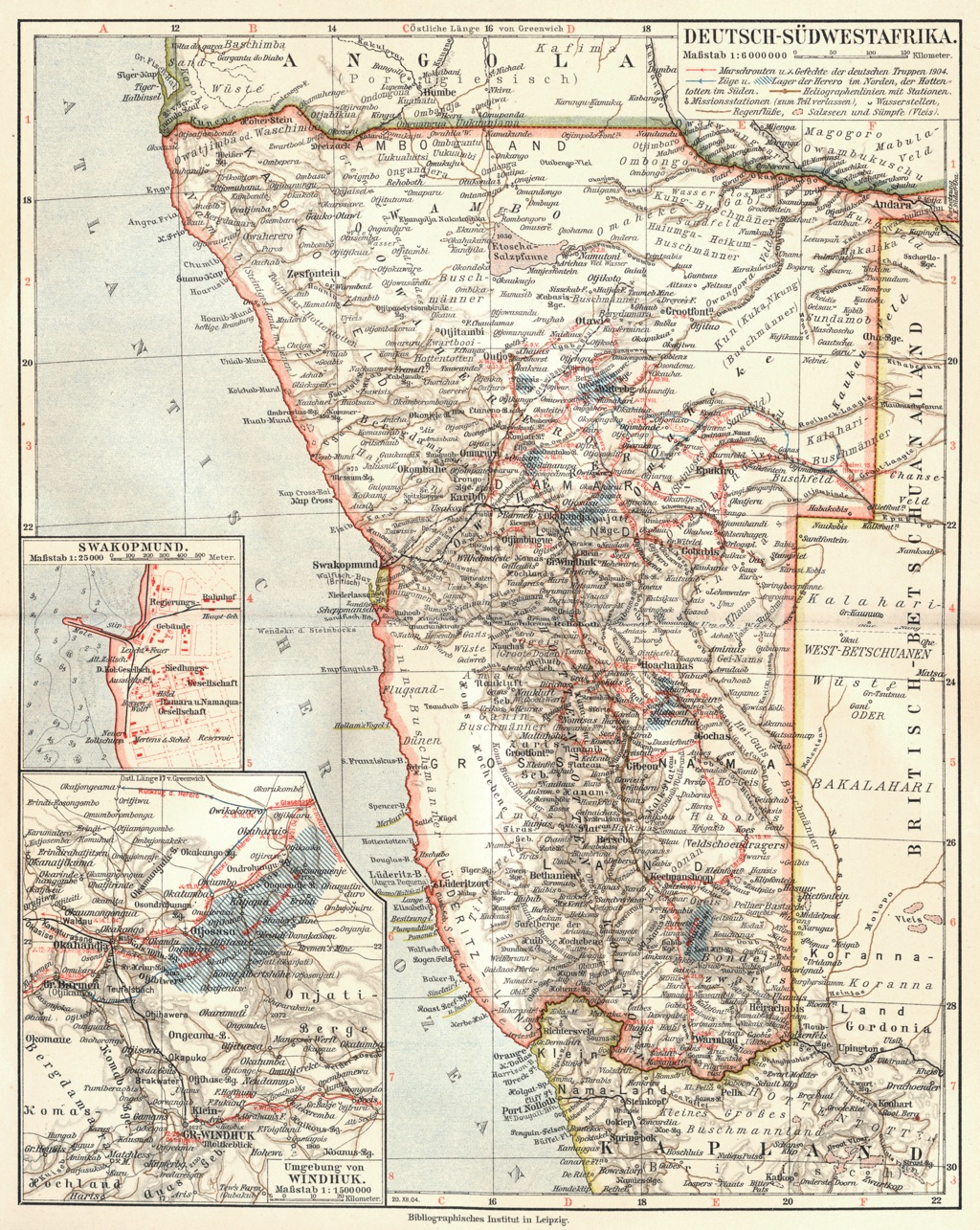 |
Karte der militärischen Aktionen
und Lager der Aufständischen von 1904 |
 |
Political
cartoon on German South West Africa (1906): "Even if it hasn't brought
in much profit and there are no better quality goods on offer, at least
we can use it to set up a bone-grinding plant."- W. Lehmann - P. 137 of
"Genocide in German South-West Africa: The Colonial War of 1904-1908
and Its Aftermath", by Jurgen Zimmerer, Joachim Zeller and E. J.
Neather, Merlin Press |
 |
Memorial in Swakopmund (2020) |
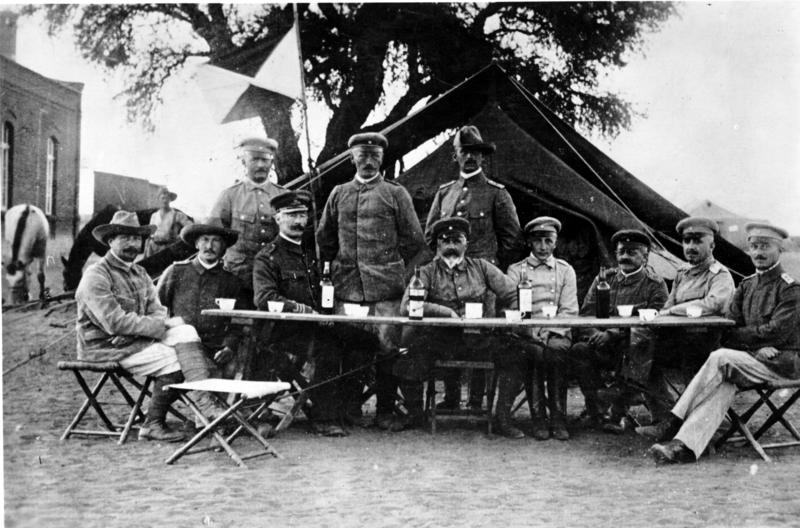 |
Central
figure Lieutenant General Lothar von Trotha, the Oberbefehlshaber
(Supreme Commander) of the protection force in German South West
Africa, in Keetmanshoop during the Herero uprising, 1904 |
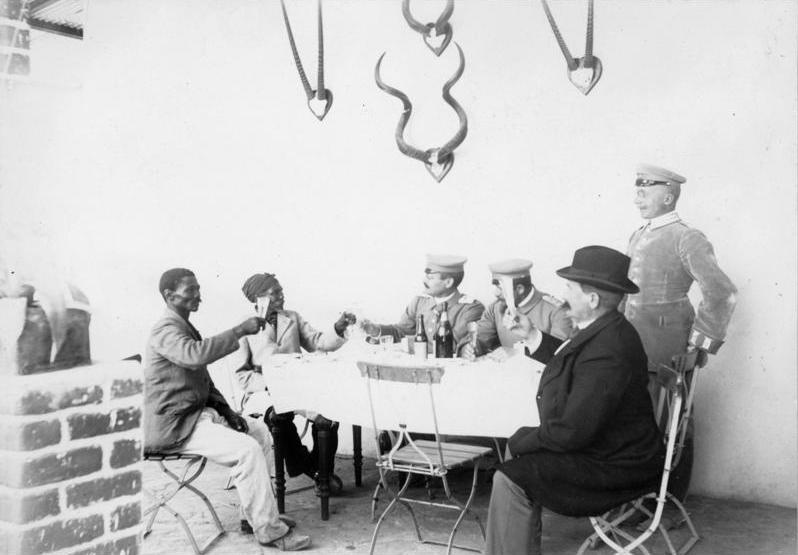 |
Theodor Leutwein toasting
Hendrik Witbooi in 1896 |
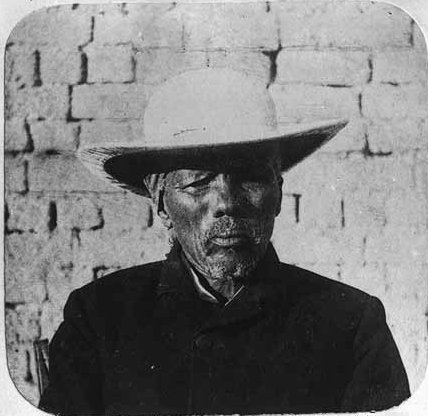 |
Nama captain Hendrik
Witbooi, c.1830-1905. |
 |
Theodor Leutwein (seated left),
Zacharias Zeraua (2nd from left) and Manasseh
Tyiseseta (seated, fourth from left), in 1895 Theodor Leutwein: Born in Strümpfelbrunn in the Grand Duchy of Baden, he joined the Prussian Army in 1868. Following several promotions he achieved the rank of major in 1893. In 1894 he replaced Curt von François as commander of the Schutztruppe (Imperial Security Troop). His personal goal in German Southwest Africa was to create "colonialism without bloodshed". During his tenure there, Leutwein created a decentralized administration with three regional centers (Windhoek, Otjimbingwe and Keetmanshoop). The construction of the first railroad between Windhoek and the seaport of Swakopmund was built during his rule. In 1899 he was promoted to lieutenant colonel, rising to the rank of colonel in 1901.[1] His policies with the native Africans, which he called the "Leutwein System", was a mixture of diplomacy, "divide-and-rule" and military coercion. His relationship with the indigenous Namaqua and Herero tribes were tenuous at best. Conversely, he was often criticized by German colonists as being too lenient with the Africans. In 1904 an uprising by the Herero was the beginning of the end of his colonial leadership. Soon afterwards, Wilhelm II replaced Leutwein with the notorious General Lothar von Trotha.[1] In May 1904 he admitted that the Germans had not taken one Herero prisoner, following an inquiry by the social democratic Reichstag deputy August Bebel.[2] In 1906, Leutwein published an autobiography, "Elf Jahre als Gouverneur in Deutsch-Südwestafrika"[3] ("Eleven Years as Governor in German South West Africa"), an historical account of his career in German Southwest Africa. He died in Freiburg.[1] Manasseh Tyiseseta: Tyiseseta was the half brother of chief Tjaherani (tenure: 1860–1884). After the deaths of Tjaherani and Christian Wilhelm Zeraua in 1884, Tyiseseta became the Herero leader of Omaruru. He signed a treaty of protection on 3 November 1885 with Heinrich Ernst Göring and the German Empire.[2] The missionaries Carl Gotthilf Büttner and Gottlieb Viehe were also present. Tyiseseta kept his tribe independent of the Germans and the chieftain Samuel Maharero for many years. trading with South Africa for weapons, ammo, and other goods. He had his own armed forces.[3] Samuel Maharero was named the chief Herero leader under German auspices in Augustus 1891, but other chiefs objected. That November 26, Theodor Leutwein negotiated a meeting between Samuel Maharero and Zacharias Zeraua, both agreeing to meet with Tyiseseta. From then on, Tyiseseta's political dominance was backed up by German military might. |
 |
Lieutenant General Lothar von
Trotha |
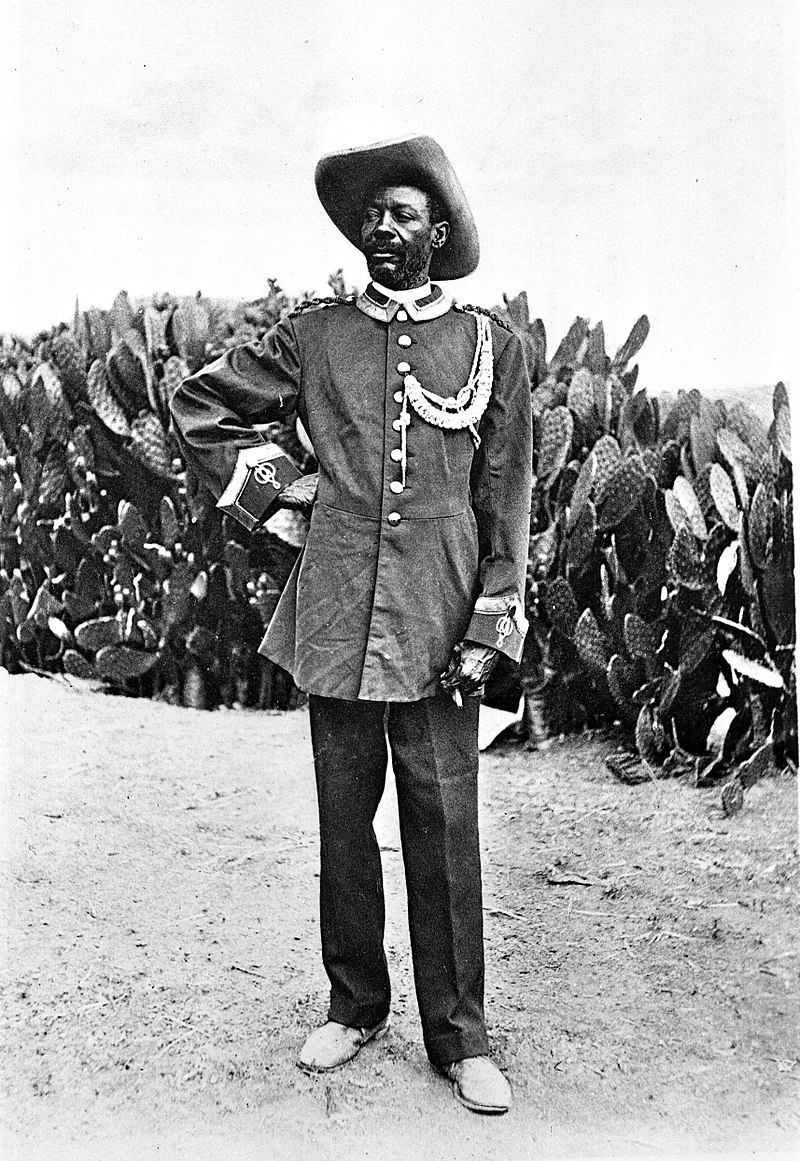 |
Samuel Mahero, Häuptling und
Anführer der Herero |
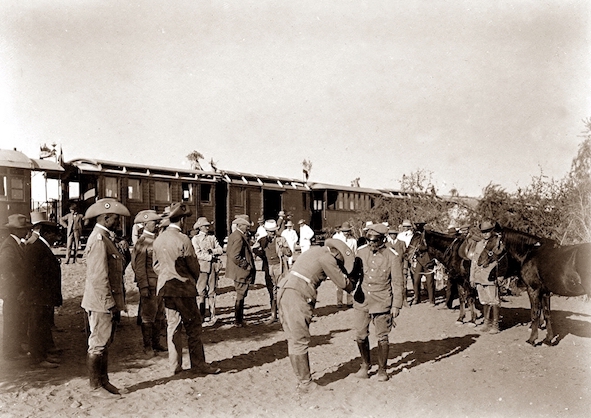 |
|
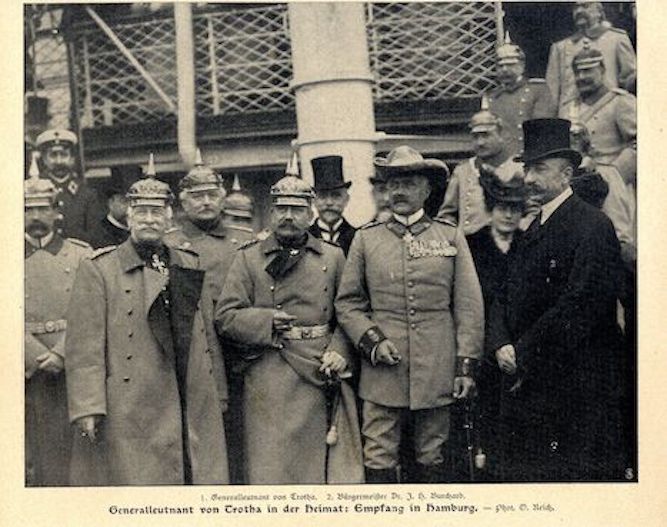 |
|
 |
Cover
of the 1918 British Bluebook, originally available through His
Majesty's Stationery Office. In 1926, except for archive copies, it was
withdrawn and destroyed following a "decision of the then Legislative
Assembly".[81][82] |
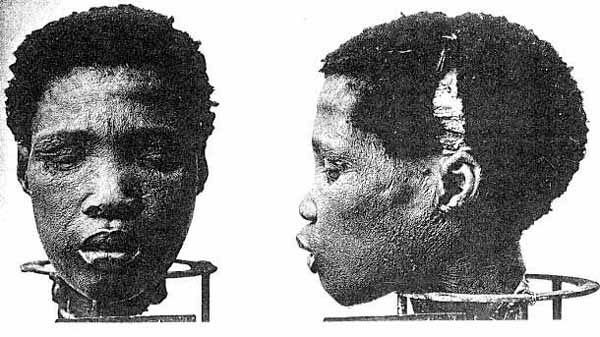 |
医学実験に使われた(とされる)シャークアイランド
の囚人の切断された頭部を写した白黒写真: Head of Shark Island prisoner used for medical
experimentation (BBC)/ Beamte verpacken Schädel von Herero in Kisten
für den Transport nach Berlin. "In 1906, research was conducted by the doctor Eugen Fischer, later a prominent Nazi scientist, on the skulls of dead prisoners[31] and on prisoners with scurvy by Dr. Bofinger. In 2001 a number of these skulls were returned from German institutions to Namibia. The captured women were forced to boil heads of their dead inmates (some of whom may have been their relatives or acquaintances) and scrape remains of their skin and eyes with shards of glass, preparing them for examinations by German universities.[32]" 「1906年、後にナチスの著名な科学者となるオイゲン・フィッシャー博士によって、死んだ囚人の頭蓋骨の研究が行われ、ボフィンガー博士によって壊血病 の囚人の研究が行われた。2001年、これらの頭蓋骨の多くがドイツの施設からナミビアに返還された。捕らえられた女性たちは、死んだ収容者(中には身内 や知人もいたかもしれない)の頭を煮たり、皮膚や目の跡をガラスの破片で削ったりして、ドイツの大学による実験の準備に使われた」 32:The Kaiser's Holocaust: Germany's Forgotten Genocide and the Colonial Roots of Nazis - p. 224 Casper Erichsen, David Olusoga - 2010 |
|
|
"A box of Herero skulls was recently packed by the troops in German South-West Africa and sent to the Pathological Institute of Berlin, where they are to be used for scientific measurements. The skulls, which were removed of the flesh and made ready for shipment by Herero women using glass shards, come from hanged or killed Hereros."(Source:https://manufacturingrace.org/1-colonialism-and-race) |
※ドイツ側の謝罪、ドイツにもち去られた研究用の頭 蓋骨等の返還請求や帰還については、香室(2019:172)に収載されている年表を参照のこと。
+++
Links
リンク
文献
その他の情報



++
Copyleft,
CC, Mitzub'ixi Quq Chi'j, 1996-2099